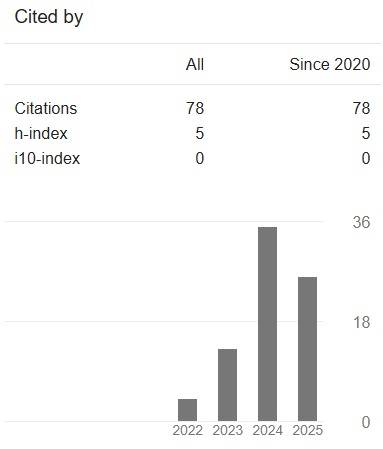Transient Thermal Analysis of Solid Propellant Rocket Motor
DOI:
https://doi.org/10.24191/jaeds.v2i1.44Keywords:
Thermal Analysis, Transient Analysis, Heat Transfer, Temperature DistributionAbstract
Rocket engines convert the chemical energy of propellants into the kinetic energy of projectiles. Consequently, the creation of stable, high-temperature combustion of propellant is critical in itsoperation. Due to the high operating temperature and pressure, it is likely that the structural strength of the rocket’s engine component will deteriorate. Thisis particularly true for small rocket engines, because, unlike large rocket engines, the small oneshas no active cooling system. Heating of engine parts beyond its designed temperature will eventually increase the likelihood of mission failure. Hence, conducting a transient thermal analysis of the components during the design of the rocket engine is critical. The thermal analysis can also be used to estimate the thermal energy distribution in parts that come into contact with the heat flow induced by propellant combustion, aidingin the selection of the correct material and geometry for rocket nozzle construction. The present study is intended to analyse the transient heat transfer by observing the temperature distribution across the material and components of the rocket, including the propellant, inhibitor, nozzle, and outer casing. Besides that, the study was aimed at investigating the rate of temperature rise within a few seconds of rocket firing. A transient analysis package in SOLIDWORKS software was employed for this purpose. A constant temperature of 1326.85 ºCwas imposed onthe inner surface of the propellant, representing the intended peak combustion temperature, while the rest of the engine parts wereset at an ambient temperature of 26.85 ºC. The analysis revealed that the inner surface of the rocket engine casing had reached a temperature as high as 181.8 °C within 0.6 s of the rocket firing. It is also found that the surface temperature increases almost linearly with time.Keywords:Thermal Analysis, Transient Analysis, Heat Transfer, Temperature DistributionNomenclature kpropThermal conductivity of the propellant (W/(m·K))kinhThermal conductivity of the inhibitor (W/(m·K))kcaseThermal conductivity of the casing (W/(m·K))hoHeat transfer coefficient (W/(m2·K))TcombTemperature of the combustion (ºC)Tsurf,initialInitial temperature of the surface (ºC)DADiameter of A (mm)DBDiameter of B (mm)DCDiameter of C (mm)DDDiameter of D (mm)∑RTotal thermal resistance (K/W)LLength (mm)????̇Rate of heat transfer (J/s)ΔToverallSubtraction of TcombwithTsurf,initial(ºC)T1The temperature of the outer surface of KNSu propellant (ºC)T2The temperature of the outer surface of the inhibitorAbbreviations6061(Unified Numbering System (UNS) designation A96061) is a precipitation-hardened aluminium alloy, containing magnesium and silicon as its major alloying elements.T6Solution heat treated and artificially agedPVCPolyvinyl ChlorideKNSuThe potassium nitrate (KNO3)/sucrose (C12H22O11) propellantDownloads
References
K. M. Pandey, K. M. Pandey, and P. Bose, “Structural Failure Analysis of Rocket Motor,” Artic. J. Environ. Res. Dev., vol. 6, no. 3, 2012.
R. E. Lee, “Heat Transfer to the Throat Region of a Solid Propellant Rocket Nozzle,” Naval Ordnance Lab White Oak Md, 1963.
M. Naraghi and E. Armstrong, “Three dimensional thermal analysis of rocket thrust chambers,” in 23rd Thermophysics, Plasmadynamics and Lasers Conference, 1988, p. 2643.
C. Madhu Suryavanshi, “Thermo-Structural analysis of rocket engine thrust chamber.” Universitat Politècnica de Catalunya, 2018.
J. Yang and M. H. Naraghi, “A fin analogy model for thermal analysis of regeneratively cooled rocket engines,” AIAA Propuls. Energy 2020 Forum, no. July, pp. 1–17, 2020, doi: 10.2514/6.2020-3817.
H. Gantina and M. D. Saputra, “Finite element modeling and analysis of heat transfer in a 122-mm diameter solid rocket nozzle,” Proc. 3RD Int. Semin. Metall. Mater. Explor. New Innov. Metall. Mater., vol. 2232, no. April, p. 040004, 2020, doi: 10.1063/5.0004770.
W.-S. Lee and Z.-C. Tang, “Relationship between mechanical properties and microstructural response of 6061-T6 aluminum alloy impacted at elevated temperatures,” 2014, doi: 10.1016/j.matdes.2014.01.053.
A. C. Foltran, D. F. Moro, N. D. P. Da Silva, A. E. G. Ferreira, L. K. Araki, and C. H. Marchi, “Burning Rate Measurement of KNSu Propellant Obtained by Mechanical Press,” J. Aerosp. Technol. Manag., vol. 7, no. 2, pp. 193–199, Apr. 2015, doi: 10.5028/JATM.V7I2.431.
F. Smithies, “Conduction of Heat in Solids. By H. S. Carslaw and J. C. Jaeger Pp. viii 386. 30s. 1947. (Oxford, at the Clarendon Press).,” Math. Gaz., vol. 36, no. 316, pp. 142–143, May 1952, doi: 10.2307/3610347.
V. Rai and S. Nigam, “Thermal Analysis of Composite Hollow Cylinders Using COMSOL Software,” vol. 15, no. 3, pp. 40–46, 2018, doi: 10.9790/1684-1503044046.
P. T. Summers et al., “Overview of aluminum alloy mechanical properties during and after fires,” Fire Sci. Rev., vol. 4, no. 1, pp. 1–36, 2015.
Downloads
Published
How to Cite
Issue
Section
License
Copyright (c) 2022 Ahmad Hussein Abdul Hamid (Ts. Dr.), Mohamad Haziq Mohamad Aliman, Zuraidah Salleh, Mohammad Juani Sujana , Osmera Ismail, Mohamad Amirul Muhammad, Mohamad Akmal Mohd Fazli

This work is licensed under a Creative Commons Attribution 4.0 International License.









